Just 15 kilometers south of Brisbane, on Australia’s eastern coast, lies the impressive Moreton Bay. This scenic angling paradise stretches across 125 kilometers, extending from Surfers Paradise in Gold Coast Seaway in the south to Caloundra in the north. Fishing in Moreton Bay is something that’s kept anglers busy for decades, thanks to its abundant waters and rich history.

Moreton Bay is sheltered by Moreton Island. It’s home to tranquil, sandy beaches, vibrant mangrove forests, and seagrass meadows. Anglers come to the bay to enjoy both inshore and offshore fishing opportunities, as well as its incredible biodiversity. Whales, dolphins, dugongs, and around a quarter of Australia’s bird species come here at some point every year.
This article will guide you through the fishing wonders of Moreton Bay, including the most productive spots, the top fish species, techniques, and more. So, whether you’re planning a weekend getaway with your friends and family, or a full-day extravaganza, prepare to be captivated by the allure of Moreton Bay.
What can I catch while fishing in Moreton Bay?
The waters of Moreton Bay are pretty shallow, ranging from 1–8 meters deep. This allows for incredibly diverse fishing opportunities. The bay’s artificial reefs and natural sand banks and islands are home to a generous variety of fish species, from the notorious Snapper to various types of Tuna, Bream, Mackerel, and Sweetlip. That’s without mentioning Whiting, Cobia, Jewfish, Cod, Trevally, Mangrove Jack, and many other species that patrol the bay.
In this section, we’ll outline our personal favorite targets, in no particular order. But here’s the bay’s superstar catch to kick us off…
Snapper
Snapper fishing in Moreton Bay should need no introduction. These gorgeous fish are so popular in the bay, that they probably deserve their own article. Snapper can grow up to a meter in length and weigh as much as 20 kilograms, making even the most experienced anglers sweat a bit.
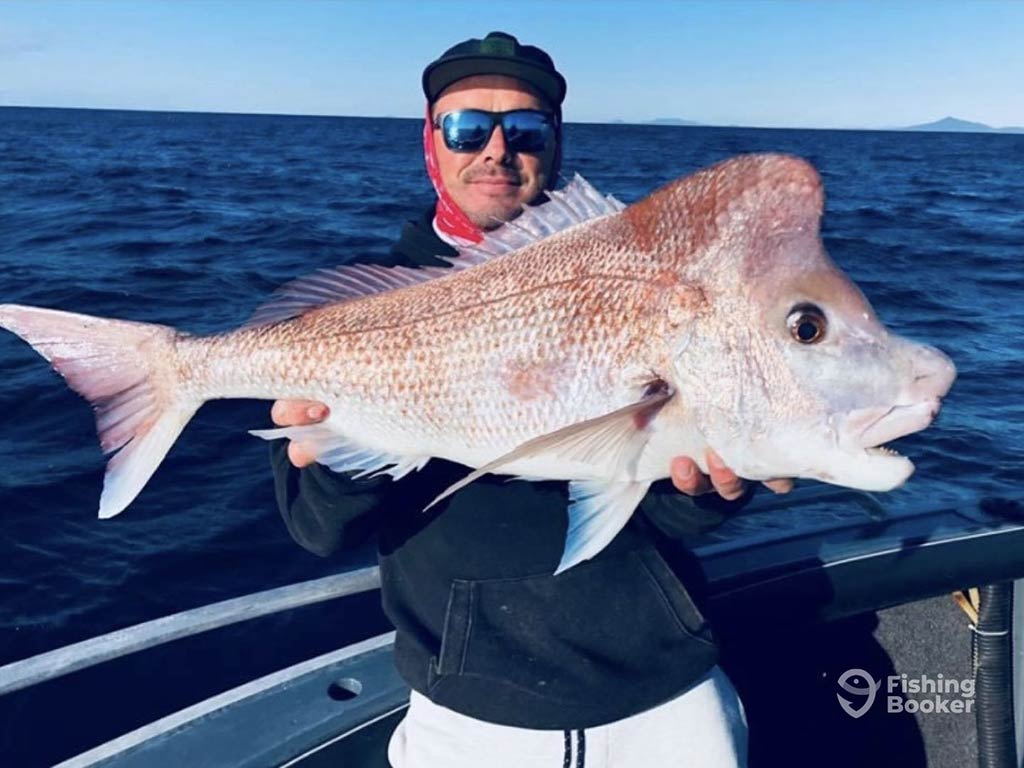
Look for Snapper in areas with reef margins or weed beds with tidal current flowing past them. The fish are known to feed around ambush points, especially with drop-offs nearby, good current flow, and a pressure point. The key to finding schools of Snapper is to look for bait fish congregations on the sounder.
50–65 cm fish are prolific around the “Mud,” the Harry Atkinson Artificial Reef, and Goat Islands, along with the island bays and channels as far south as the Logan River. The overall best time to fish for Snapper in the bay is during the cooler months, from April through October. But these locations can be productive any time of the year. Tides and lunar cycles aren’t as important, here, although you might get the best bite around dawn after new and full moons.
Locals use light tackle and tend to keep their presentation very quiet to not spook the fish. Some of the most effective lures are small plastics rigged on a 1/8th jig head that you can cast along the reefs’ drop-offs.
Note that there are closed seasons for Snapper fishing. Make sure to consult with your guide and follow the regulations outlined by the Department of Agriculture and Fisheries.
Sweetlip Emperor
Snapper aside, there are plenty more fish in the sea, and Moreton Bay is no exception. Sweetlip Emperor are tasty bottom-dwellers that patrol the rocky reefs, wrecks, and artificial reefs. The Amity and Harry Atkinson Artificial Reefs, along with Peel Island, Hutchinson Shoal, and the Flinders Reef are good spots to explore.
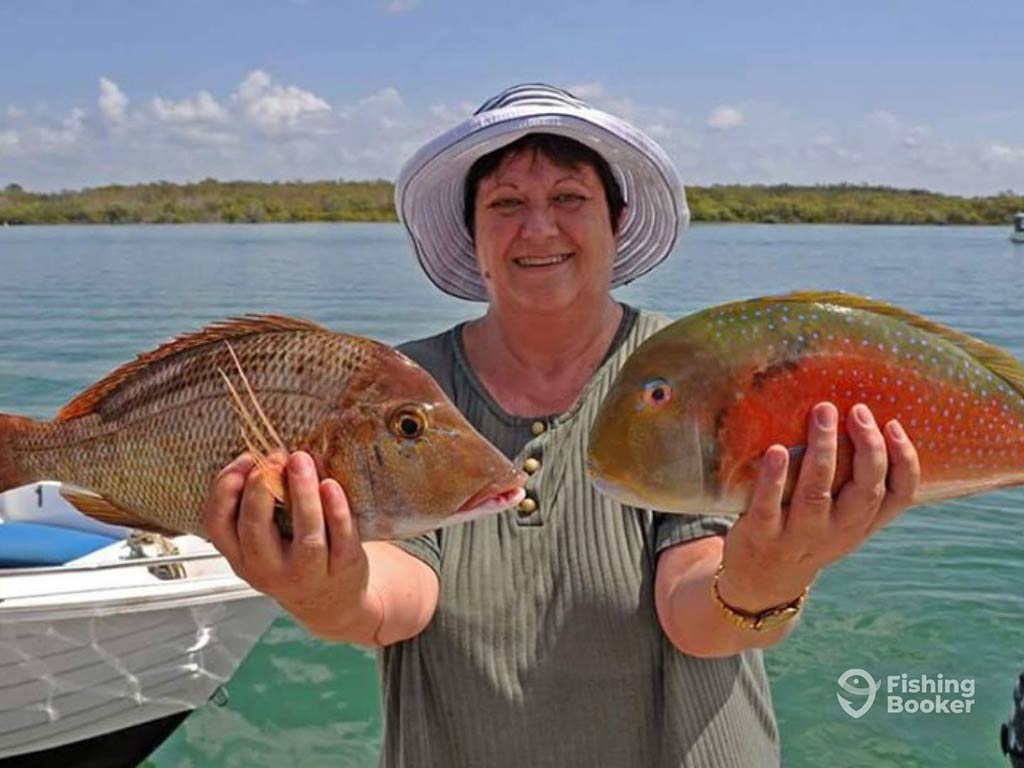
When working the shallows, you’ll most likely come across two types of Sweetlip: Grass and Spangled. The keeper Grass needs to be at least 30 cm for you to keep, with a maximum possession limit of 10 fish. You can keep only five Spangled Sweetlip, although slightly bigger: the minimum size is 45 cm. Since the regulations can change, make sure to double-check everything ahead of time.
Grass Sweetlips hang out close to juvenile Snapper and Bream, while Spangled patrol deeper waters with good drop-offs. If you’re fishing a rising tide in 3–8 meters of water, chances are you’ll come across Grass Sweetlip, while waters at least 10 meters deep are best for Spangles.
Avoid using a sinker and let the bait (small plastics or live bait) drift slowly down through the water column. If the current is pretty strong, add a small sinker and ⅛ oz jig head. Moreton Bay anglers fish at dawn and dusk, concentrating their efforts from June to September. Sweetlips are around throughout the year, but the bite is weaker from November through February.
Mackerel
Mackerel are fast predators with razor-sharp teeth that keep anglers busy throughout the year. Moreton Bay anglers typically land 50–75 cm Mackerel, with 50 cm being the minimum legal size. And on that note, you’re only allowed to keep 10 fish per person.

So, where do Moreton Bay Mackerel bite best? Start your journey on the southern end of Moreton Island, then move to the eastern side of North Stradbroke Island or the Tweed Heads Artificial Reef. Or, alternatively, check everything in between. Some of the most productive spots are deeper areas around the Rous Channel or the shipping channels.
When picking the right gear, consider a rod in the 4–10 kg range matched with a 3000–5000 spinning reel. If you’re lucky enough to hook into a larger fish, carbon drag washers can be a good addition to your reel. While rigs usually do the job, some locals use live bait. Unweighted live baits can be pretty productive one day, while on other days, you may want to fish live bait on the bottom.
Flathead
Moreton Bay Flathead are among the most popular target here, thanks not only to their delicious taste, but also the fact that they’re easy to catch. Well, relatively easy to catch, anyway. The fish bite best from November to April, although you can find them in the bay throughout the year.

The shallow flats around Kalinga Bank, Cabbage Tree Point, Jacobs Well, the mouth of the Logan River, the southern end of Peel Island, the Rous Channel, and Jumpinpin are among the most productive Flathead spots. In general, anglers look for them in shallow sandy areas near mangroves or in deeper channels, casting into drains on low or high tides.
When targeting Dusky Flathead, consider looking for female species, since they tend to grow much larger than males and also live longer.
Bream
While Moreton Bay Bream aren’t exactly wall-hangers, these smaller fish species are perfect for beginner anglers from November to March. In some cases, you can target them in the mix with bigger fish to keep things interesting.
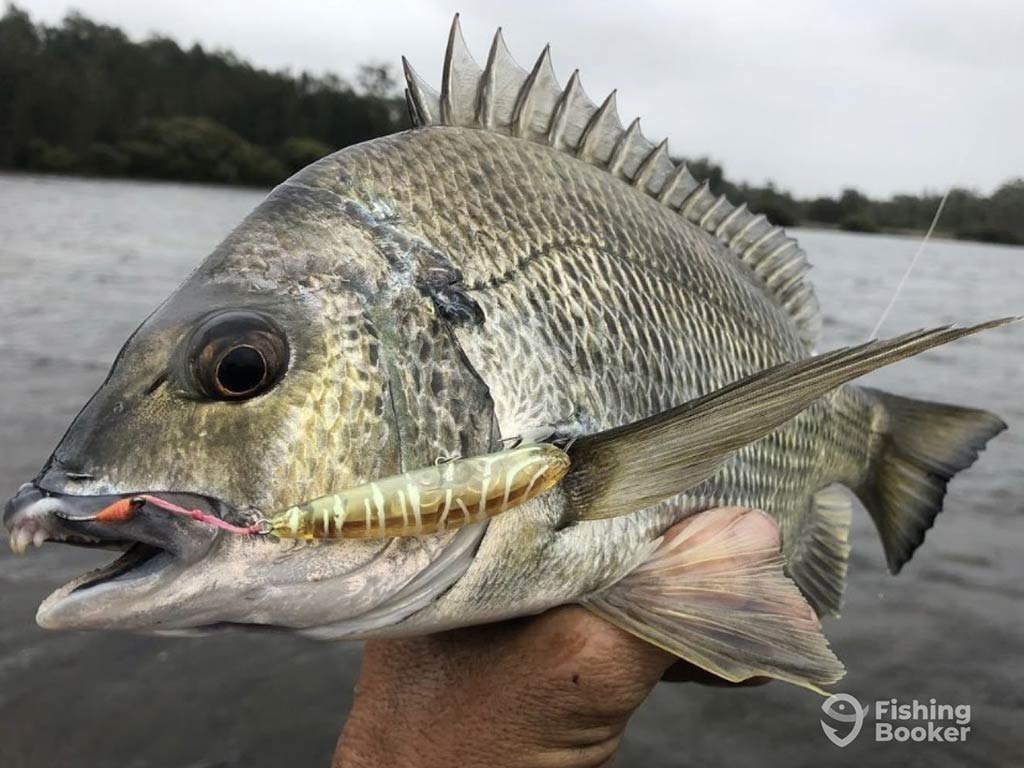
Look for shallow waters around oyster beds, rocky outcrops, and mangroves. The Brisbane River, Tingalpa Creek, and Cabbage Tree Creek hold good numbers of Bream. Incoming tides seem to make the fish push up into the areas looking for food, which you can use to your advantage.
Ask any local, and they’ll most likely tell you that Moreton Bay is a mecca for targeting Bream on crankbaits. Try different depths, mimicking the bait and tapping into the feeding patterns. If you’re after something visually pleasant, consider using small surface poppers and stickbaits.
Just like every other species, there are certain limits and regulations when it comes to Moreton Bay Bream. The bag limit is set for 10 fish per person, while the minimum size of keeper fish is 25 cm. As usual, double-check the regulations with your guide or online before you hit the waters.
Tuna
Tuna fishing in Moreton Bay certainly needs no introduction. When the season allows, anglers hop on board their boats and head to the local honey holes to hunt for Yellowfin, Longtail, and Mack Tuna. Fly fishing, trolling with live bait, casting and retrieving lures – there are many techniques that you can try.

Some of the best spots in the bay include the shipping channels, the Tweed Heads Artificial Reef, and offshore reefs such as Hutchies Reef and Flinders Reef. Look for bait schools and bird activity on the surface to locate your target.
The whole spectacle of Tuna fishing depends on whether you’re using the right gear – and some luck! Tuna generally feed into the wind, so make sure the boat is positioned right. It’s never a bad idea to head out with a local skipper who knows how to maximize your chances at a successful catch.
Generally, the best time to go Tuna fishing in Moreton Bay is through autumn and early winter, especially if you’re after Longtail. If you’re fishing in spring and summer, target other Tuna or look for the Tuna schools that are attacking bait fish on the surface.
Moreton Bay Fishing Spots
It’s safe to say that the whole of Moreton Bay is one big honey hole. There’s a myriad of reefs, some productive shipwrecks, drop-offs, and other types of structure that are good places to start your excursion. The vast area of the bay spans over 1,500 square kilometers, so picking the most productive spot is definitely a challenge.
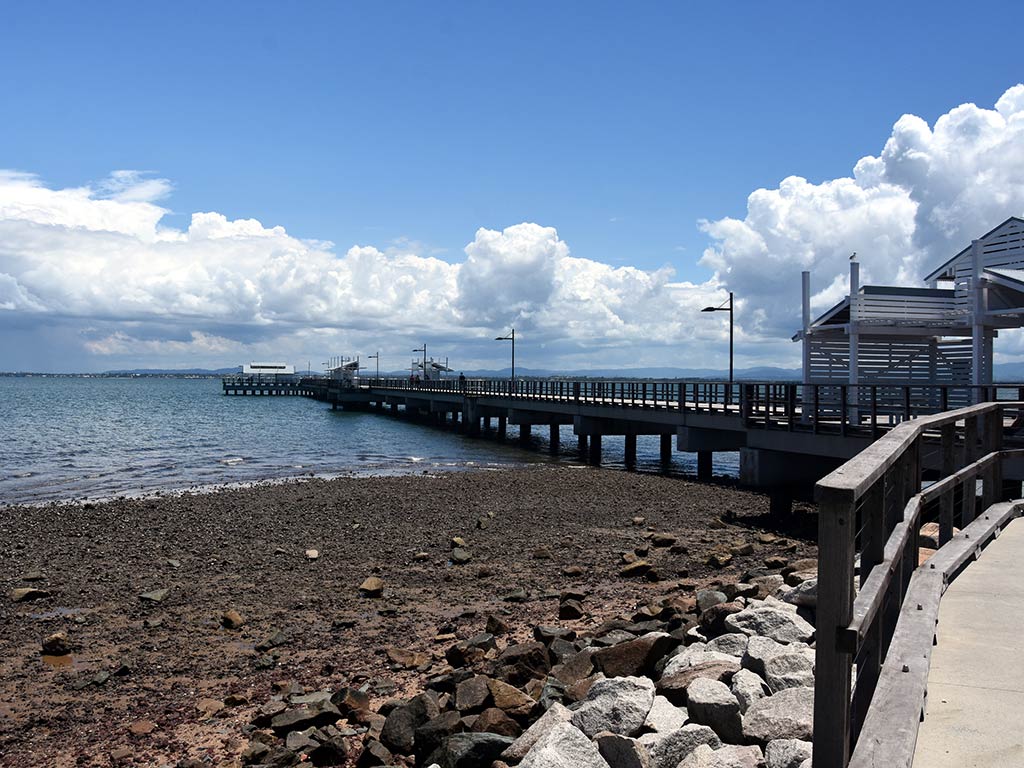
Peel Island, for instance, sits in the southern part of the bay, offering some of the best opportunities for Flathead, Bream, and Snapper, as well as Tuna, Mackerel, and Sweetlip. Another good spot for Tuna and Mackerel is Moreton Island, especially its western side – the Tangalooma Wrecks.
The bridges and jetties of the Brisbane River offer good Bream and Tailor fishing, while Kalinga Bank in the northern part of the bay is a good spot for Flathead and Whiting. If that’s not enough, consider paying a visit to the deep-water Rous Channel or the Wester Rocks off the northwest end of Moreton Island near Yellow Patch. But here’s a breakdown of the best reefs:
Top Moreton Bay Reefs
- Amity Artificial Reef: This popular Snapper and Sweetlip fishing spot is located just off North Stradbroke Island.
- Harry Atkinson Artificial Reef: This reef is based just off the coast of Brisbane, offering a good selection of reef fish species, such as Snapper and Sweetlip.
- Curtin Artificial Reef: This spot contains about 20 wrecks and other materials on sandy bottoms, attracting various pelagics.
- Coochiemudlo Island Artificial Reef: The Coochiemudlo Island reef holds both pelagic and reef fish species. It’s approximately 8 meters deep.
- Hutchies and Flinders Reefs: These offshore reefs are located off the coast of Brisbane, attracting anglers hunting for Tuna, Mackerel, and Sweetlip.
- Scarborough Reef: This is a reef system at the northern end of Moreton Bay. The reef drops to depths of around 20 meters, offering excellent bottom fishing opportunities.
How can I go fishing in Moreton Bay?
Depending on what species you’re after, you’ll be able to pick the right technique. While fishing methods vary, there are certain types of angling experiences everyone can enjoy. Let’s see what anglers favour in Moreton Bay.
Shore Fishing

If you’re the type of angler that finds peace just standing on a beach with a rod in the water, waiting for the fish to bite, then shore fishing is the best option. There are jetties, breakwaters, rock walls, and beaches where you can wet a line. The list of your potential targets varies from Tailor to Mackerel.
There are various land-based spots you can explore in the area. Cleveland and Wellington Points have jetties that extend out in the bay. There’s also Victoria Point with a few jetties and rock walls that are good for targeting Flathead and Bream.
If you don’t mind a longer trip, Moreton Island offers some nice shore fishing opportunities. Meanwhile, Tailor and Whiting bite well around the Tangalooma Wrecks and along the surf beaches.
Charter Fishing

While Moreton Bay offers a wide range of fishing opportunities, it’s never a bad idea to head out with a local guide. There are various professional crews that cater to anglers of all ages and skill levels – and budgets, too.
Whether you’re looking to explore the artificial reefs or venture out to one of the islands, consider booking a trip with a charter skipper. A knowledgeable guide knows the area better than anyone else, and fishing with an experienced crew maximizes your chances at landing anything from larger predators such as Tuna and Mackerel to smaller fish like Bream. Use the know-how and know-where to your advantage.
When can I go fishing in Moreton Bay?
Throughout the year, there’s always something biting in Moreton Bay. While a lot of fish species are available all year round, every angler needs to get familiar with various closed seasons and regulations.
The cooler months, from May to September, are best to target reef species, such as Snapper and Sweetlip. If pelagics sound more alluring, consider booking a trip during the warmer months – from November to April. Mackerel, Tuna, and Tailor bite actively in the shallows during these months.
September to January is the best time to target Cobia. But from November to March, a lot of Moreton Island anglers head to the drop around 50 miles offshore to target large predators, including Billfish.
When it comes to picking the right time of the day, early mornings and late afternoons are generally the most productive. The water temperatures are cooler, making the fish much more active.
Moreton Bay Fishing FAQs
Fishing in Moreton Bay: The Fishing Is Always On
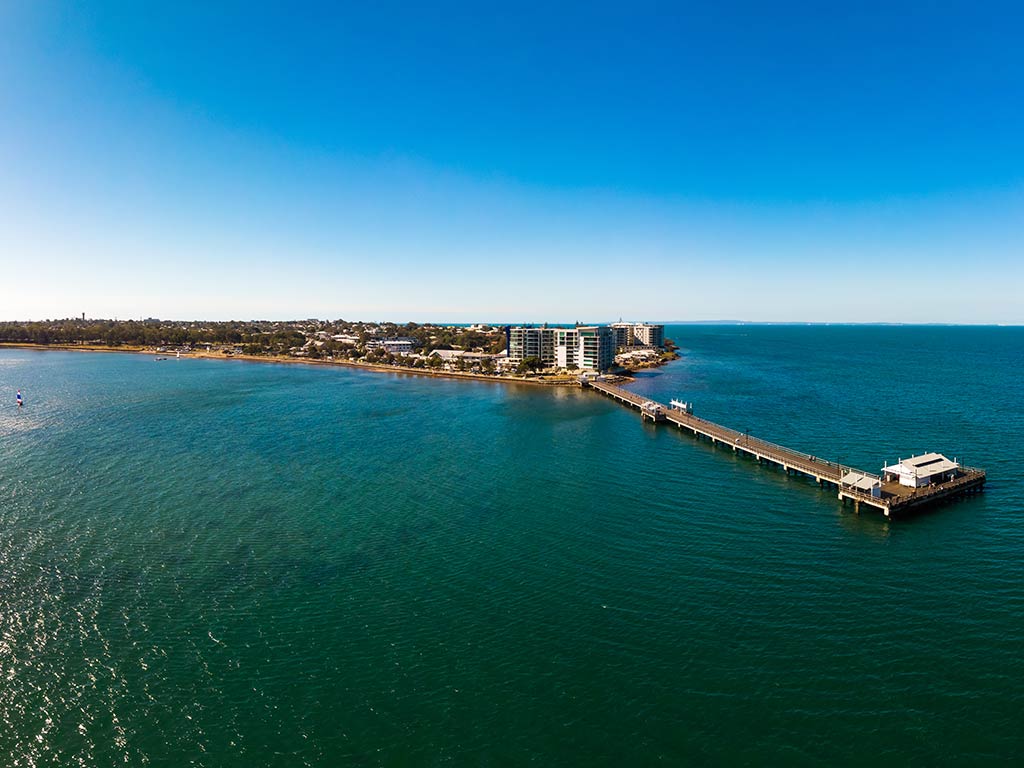
The pristine East Coast of Australia is full of adventures, and Moreton Bay is no different. With a shallow water playground full of everything your heart desires, it’s hard to resist a trip to cast your line. If you’re into fishing, Moreton Bay can hardly disappoint. Pack your rod and reel, find a suitable guide, and venture out to explore!
Have you ever been fishing in Moreton Bay? What’s your most impressive catch? Was it Snapper or Sweetlip that made you fall in love with the area? Let us know in the comments below!
The post Moreton Bay Fishing: The Complete Guide appeared first on FishingBooker Blog.
https://ift.tt/g1ayIh7
0 Comments
Enregistrer un commentaire